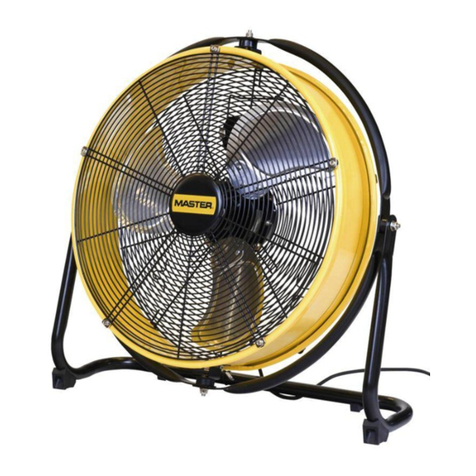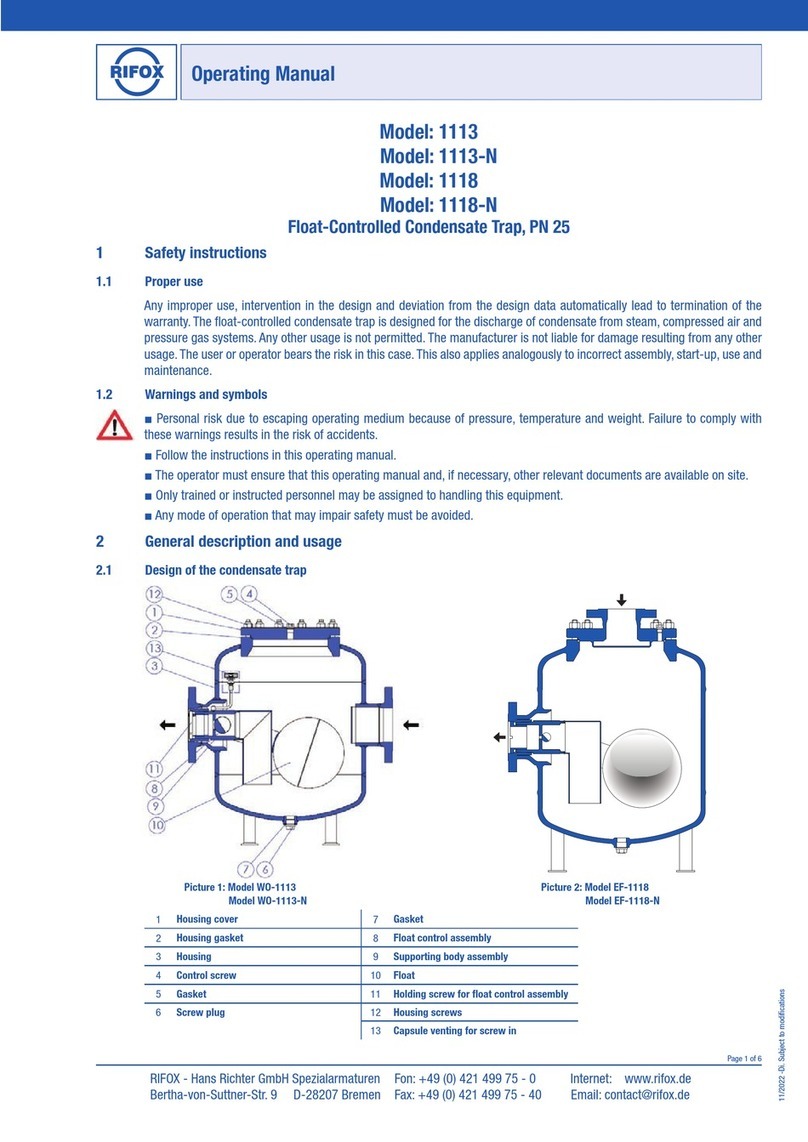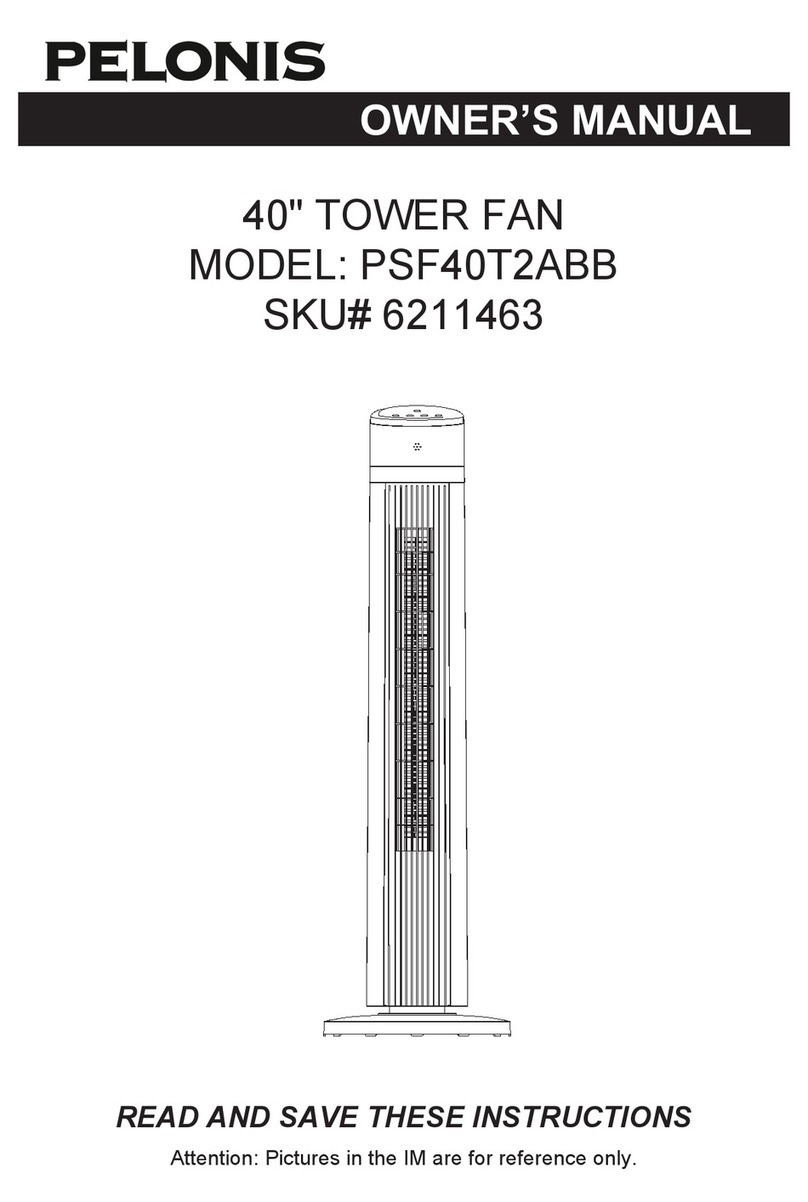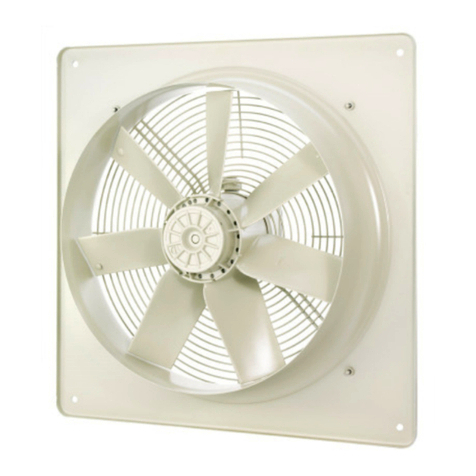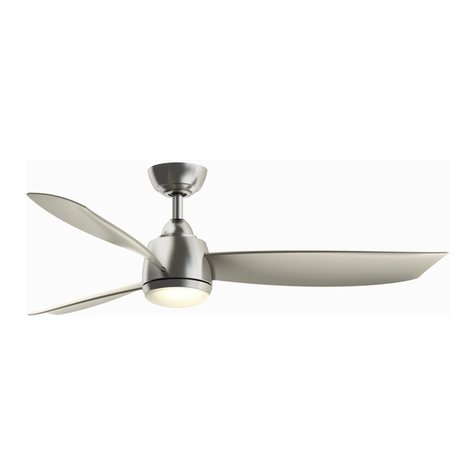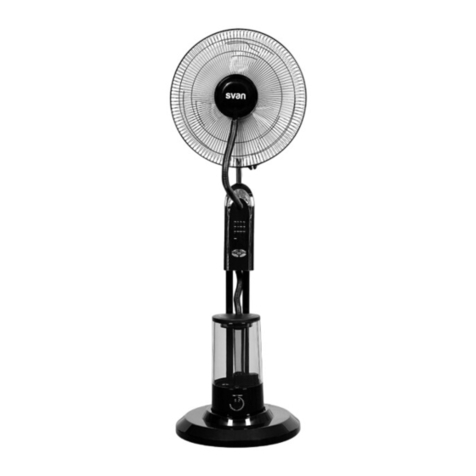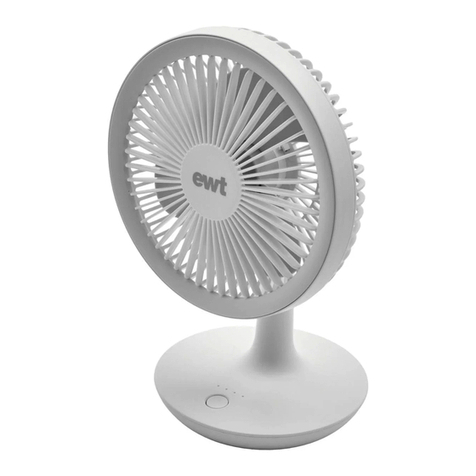NovelAire ECW Operating instructions

Energy Conservation Wheel
Operating and Maintenance Manual

CONTENTS
SECTION I: Introduction and Definitions....3
Introduction................................................................3
Definitions .................................................................3
SECTION 2: Receiving and Inspecting........4
Receiving...................................................................4
Lifting and Handling..................................................4
Storage.......................................................................4
Figure 1- Cassette Components ..........................................4
Section 3: I
nstallation
............................5
Identification Markers................................................5
Installing ....................................................................5
Figure 2- Cabinet Installation Guide ...................................5
Section 4: Controls and Wiring....................6
Drive Motor ...............................................................6
Variable Speed Control..............................................6
Frost Prevention Measures.........................................6
Section 5: Startup and Operation................7
Prestartup Checks ......................................................7
Seal Checks................................................................7
Variable Frequency Drive (VFD)..............................7
Adjustable Purge........................................................7
Section 6: Maintenance ................................8
Bearings.....................................................................8
Drive Motor ...............................................................8
Drive Belts.................................................................8
Seals...........................................................................8
Wheel Cleaning ..........................................................8
Basic Cleaning .....................................................................8
Wheel Washing within Cabinet: .........................................8
Wheel Washing Removed from Cabinet: ...........................8
Variable Frequency Drive..........................................9
Section 7 –Belt Installation........................10
Sheet Metal Cassette Belt Installation .....................10
Welded Box Tube Belt Installation..........................13
Section 8: Troubleshooting........................15
Appendix 1 –Powertwist Belt...........................................16
Appendix 2 –External Pillow Block Bearing......................17
Appendix 3 –External Flange Bearing ..............................18
Appendix 4 –Internal Insert Bearing................................18
Appendix 4 –ECW General Arrangements .......................19

Page | 3 2/25/2021
SECTION I: INTRODUCTION AND DEFINITIONS
INTRODUCTION
Your NovelAire Technologies energy conservation wheel (ECW)
cassette comes complete and ready to run. The ECW cassette is
built to provide many years of trouble-free service. With proper
installation and performance of the minimal maintenance
requirements, your ECW should operate problem free.
Please review these instructions carefully before installing the
unit. Most damage occurs due to improper installation. NovelAire
is not responsible for a unit that has been improperly installed.
The rotor media can be torn or crushed by mechanical means if
the unit is improperly treated.
This document covers operating and maintenance instructions for
both the total heat wheels (ECW) and sensible only wheels (SEW).
For questions, please contact NovelAire Technologies at:
Ph: (800) 762-1320 or (225) 924-0427
Fx: (225) 930-0340
Email: info@novelaire.com
DEFINITIONS
Bearing, external - Flanged or pillow block bearing used with
rotating shaft models in larger, welded units.
Bearing, internal - Sealed ball bearing used with fixed shaft
models in smaller, sheet metal units.
Brush seal - The seal used for both the perimeter seal and the face
seal in the NovelAire ECW cassettes. They are constructed of nylon
brushes and seal against the wheel band in the case of the
perimeter seal and are siliconized and positioned against the
wheel surface in the case of the face seal. These seals are
noncontact in that there is a slight gap between seal and sealing
face to allow the wheel to turn at high RPMs without over-
torquing motor or causing seal damage. These seals have an
integral clip and are clipped to the cassette face panel cutout
(perimeter) or to the post (face).
Cassette - The steel structure that houses the rotor. ECW cassettes
are of punched sheet metal panelized construction. Large
cassettes are of welded box tubing construction.
Energy Recovery Unit (ERV) - The unit that the ECW fits into. This
will typically include two blowers and the ECW cassette all
enclosed in a sheet metal housing.
Enthalpy wheel - A generic name for an energy conservation
wheel. The term enthalpy refers to an air stream's total energy
(temperature and humidity level).
Exhaust air - The air stream leaving an ECW that is exhausted to
the outside. Exhaust air is building return air that has been run
through the wheel.
Heat wheel - Synonymous with enthalpy wheel, energy
conservation wheel, or total energy recovery wheel. Some heat
wheels are sensible only wheels and should not be confused with
total energy recovery wheels.
Hub - The center support of an ECW.
Latent energy - Latent energy in the context of wheel discussions
is the work done by the wheel to transfer moisture from one air
stream to another. Latent work is accompanied by humidity
changes in the air streams.
Media - The chemical composite part of the wheel which performs
the latent and sensible exchange.
Outdoor air - The air stream entering an ECW that is brought in
from outside. Outdoor air becomes supply air after going through
the wheel.
Purge - A small segment of supply air defined by the gap between
the inner seal on the outdoor air edge of the center post and the
supply air edge of the center post. The purge angle is adjustable.
The purge captures the small amount of supply air captive in the
wheel when the wheel moves from return to supply and routes it
to thereturn air to minimize cross contamination.
Return air - The air stream entering an ECW that is returned from
the building. Return air becomes exhaust air after going through
the wheel.
Rotor - The part of an ECW that does the energy exchange and
consists of the wheel media, hub, spokes, and band.
Sensible heat - Sensible energy in the context of wheel discussions
is the work done by the wheel to transfer heat from one air stream
to another. Sensible work is accompanied by temperature
changes in the air streams.
Sensible wheel - A wheel that does only sensible work, i.e., where
only heat is transferred from one air stream to another and the
resultant moisture level remains essentially unchanged.
Spoke - Flat metal member used to support the wheel radially.
Supply air - The air stream leaving an ECW that is supplied to the
building space. Supply air is outdoor air that has been run through
the wheel.

Page | 4 2/25/2021
SECTION 2: RECEIVING AND INSPECTING
RECEIVING
Upon arrival of your ECW, please inspect cartons, pallets, and
packaging for any damage that may have occurred during
shipping. Neither NovelAire nor its customer is responsible for
shipping damage, and it is important to identify any such damage
before the unit is offloaded. Report any shipping damage
immediately to shipper and NovelAire Technologies so that the
proper remedies may be taken.
If the unit has come shipped on a pallet, please use proper forklift
procedures to offload the pallet. The media can be easily damaged
by the forks on the forklift.
LIFTING AND HANDLING
The ECW comes complete with lifting lugs. Lugs are located on top
of the unit housing. Large ECWs have 4 lift points and small ECWs
have 2. Use only the lifting lugs to off load an ECW that is not
palletized. If the unit is palletized, it may be lifted either by the
lifting lugs or with the forks placed underneath the pallet. In no
case should the unit be lifted by any other means.
Small ECW units do not typically come with lifting lugs and can be
lifted by hand.
STORAGE
The unit should be stored out of the weather. Make sure the unit
is covered to prevent dust and dirt collection on wheel face during
long periods of storage.
FIGURE 1- CASSETTE COMPONENTS
1. Cassette Housing
2. Drive Sheave
3. Drive Belt
4. Drive Motor Mount Bolts
5. Perimeter Seal
6. Spoke
7. Outer Band

Page | 5 2/25/2021
SECTION 3: I
NSTALLATION
IDENTIFICATION MARKERS
Look for any identification markers that have come with your
ECW. Rotational direction and/or air stream orientation will be
marked on your unit. The air flow orientation should be identical
to that of the general arrangement drawing which was provided
to you during initial placement of the order. Check to make sure
that air flow orientation is as requested. Consult the general
arrangement drawing provided earlier. It is important that the unit
be installed with the right rotational directions. It is also important
that air flows be oriented as designed to allow the purge to
function as designed.
Consult NovelAire Technologies if you have problems with any of
these instructions or if the unit is improperly marked.
INSTALLING
Make sure that the installation plan is consistent with
identification markers.
Locate the purge side of the unit. The purge should always be in
the supply air stream. The ECW accomplishes “purging” by
removing a small wedge of supply air and routing it to return air.
Thus, when the wheel is in rotation, the small amount of stale
return air that is trapped in the wheel section rotating from
building to outdoor air side is isolated and routed to the exhaust
air stream.
The installation requires ducting to 4 air streams.
It is good practice to include means for accessing the ECW
cassette on all sides. This can be done either using 4 access doors,
or 2 access doors with provisions for a removable section of front
and back duct. NovelAire recommends including a removable
plenum section (see Figure 2) in the front and back of the cassette
for expedient repair and/or wheel removal. Alternatively, the
cassettes can be installed on a slide-out track for easy access.
Access must be provided to the shaft and bearings for servicing.
Before installation, inspect the cassette for loose screws or bolts.
Tighten any loose connections.
Small units (under 60 inches) can be installed in either a horizontal
or vertical orientation. Larger units must be pre-engineered to run
in the horizontal position as they require thrust bearings and
additional supports. If the unit was not pre-ordered to run
horizontally, do not install the unit horizontally. Vertical units
should be supported from the bottom in the installed position.
Horizontally mounted units should be supported at all four comers
and in the center.
Before installing, turn the wheel by hand in the direction of
rotation to ensure that the wheel alignment was not altered in
shipping. If severe binding occurs, it could be due to excessive seal
contact. In this case, adjust the seals according to the instructions
given in theseal adjustment procedure in section 5.
The ECW seals were preadjusted before leavingthe factory.If upon
inspection excessive clearance between seals and sealing surfaces
is found, adjust the seals according to the procedure given in
section 5.
Inspect the drive belt and make sure that it is securely fastened
around the drive sheaves and wheel. Ifpossible, test run the wheel
before installation.
Install the unit. Once the unit is in place, secure the ductwork to
the cassette with sheet metal screws, bolts, welding, or alternate
method of attachment. Gasketing may be used at the joints, but it
must be installed securely so that it cannot detach and cause rotor
damage. The duct work should be securely fastened to the
cassette at all locations.
The wheel should be protected using an ASHRAE 30% filter
installed in both the outdoor air and return air streams.
FIGURE 2- CABINET INSTALLATION GUIDE
Suggested access doors and removable panels to facilitate wheel removal.

Page | 6 2/25/2021
SECTION 4: CONTROLS AND WIRING
DRIVE MOTOR
The ECW comes standard with a constant speed drive motor at a
voltage requested by the customer. The typical motor voltage
options are: 115/208-230v 1 phase, 208-230/460v 3 phase, or 575v
3 phase. ECW motors are standard motors and should be wired
like any standard motor. For multi-voltage motors, ensure to read
and follow the wiring schematic on the motor or manual for the
applicable voltage required in the unit.
Single phase motors come prewired for correct rotation direction,
but rotation direction should be verified. Three phase motors
must always be checked for correct rotation direction as the local
power determines which direction the wheel will rotate when
power is connected.
Follow the directions on the motor schematic accompanying the
motor. Once the motor is wired, test run the ECW and check for
proper rotation.
VARIABLE SPEED CONTROL
If the variable speed option has been supplied, the variable
frequency drive’s (VFD) power rating, power supply, and motor
selection have all been matched up by the manufacturer. The unit
can accept either a 4-20ma or 0-20ma control signal or a 0-5VDC
or 0-10VDC. The unit has also been programmed for the range of
wheel speed operation recommended by the manufacturer.
Typical wheel speed is 35 RPM, but the programming can allow for
wheel speeds above or below 35 RPM. Check all factory settings
to make sure they are consistent with the application. Consult
NovelAire for any help in achieving the right setup for the
application.
The VFD may have been shipped loose for flexibility in mounting.
Locate the VFD where it can be read and reached easily. Mount
the VFD where it is protected from the weather.
The control signal to the VFD is customer supplied, but typically it
will be either a temperature or a humidity reading. Typical wheel
speed will be controlled either by exhaust humidity or exhaust
temperature measurement. Some applications for sensible wheel
exchangers in desiccant cooling systems may call for wheel speed
controlled by supply temperature.
FROST PREVENTION MEASURES
During extremely cold wintertime conditions, frost formation
becomes a possibility. The stream that is under risk from frost
formation is the exhaust air stream. Frost formation will basically
act to plug or reduce air flow and will not hurt the wheel itself.
Wheel speed control works to limit frost formation by reducing
wheel performance to a level where the exhaust air temperature
is kept above the dew point. Proper dew point control of exhaust
air can be determined using a psychrometric chart by:
1. Locating the wintertime design return air condition and
outdoor air condition and connect the two points on a
psychrometric chart.
2. Determine the dry bulb temperature at which this line
intercepts the saturation curve.
3. Add 2 degrees and set dew point control at this point and
vary wheel speed downward to control at or above this
point.
4. Audit performance of the wheel during actual operation.
If frost formation is never evident, it may be because
design conditions are never reached in which case it may
be possible to gradually work dew point control down.
Some of the frost control methods (www.ahrinet.org) that can be
used for all types of exchangers are:
Exhaust only: When frost is indicated on the component, the
intake blower is de-energized for a period of time to allow exhaust
air to warm component, melt frost, and drain or evaporate
condensate. Alternatively, exhaust-only operation is determined
based on outside air temperature to avoid frosting.
Preheat: For outdoor air preheat, heat is provided in the outdoor
air intake to heat the air to a temperature above the exchanger
frost threshold before it enters the component. Alternatively, for
return air preheat, heat is provided in the return air before it
enters the exchanger to prevent frost from forming.
Re-circulation: When return air or exhaust air re-circulation is
used, return air or exhaust air is substituted, in whole or in part,
for outside air passing through the exchanger for defrost
purposes.
Bypass: A portion of the outdoor air is bypassed around the
exchanger until the frost threshold is avoided.

Page | 7 2/25/2021
SECTION 5: STARTUP AND OPERATION
PRESTARTUP CHECKS
Before starting up the unit, check the following:
1. Does the rotor rotate freely by hand? If not, recheck the
seal to determine whether it is binding and if so, adjust
seals following the instructions below.
2. Is the motor rotation correct? This can be checked by
detaching the belts from the drive sheave and bumping
the motor. The sheave should be rotating in the direction
such that the belt will result in rotation per the exterior
markings. If not, rewire the motor.
3. Does the air flow orientation match up to design? See the
identification markings on the cassette and/or refer to
the general arrangement drawing to check the four duct
connections to the unit.
4. Are the belts on correctly and sufficiently tight? Belt
length is set by the manufacturer. Consult NovelAire if
the belt appears too loose.
5. Is the VFD programmed to control the unit and to prevent
frost formation? If not, follow the instructions in the
manual accompanying the VFD and/or consult NovelAire.
SEAL CHECKS
The ECW is provided with a nylon brush seal which provides not
only an effective seal in both the peripheral and side-to-side
sealing directions but also one which is easily adjusted to
compensate for seal run- in, shipping misalignment, etc. The brush
seal is attached to a metal reinforced U-shaped neoprene grip. The
metal/neoprene grip allows for an expandable grip range which
can be moved closer or further from the sealing face as needed.
The perimeter brush seals against the wheel outer band and the
inner, siliconized brush, seals against the wheel face. With the
wheel stopped, move seals as close to the sealing surface as
possible but without exceeding grip range of brush seal and
without pressing the brushes down against the seal face. Bump
the motor. If the motor will not turn, the seal is too close and
should be nudged back where needed. The seal will seek its
equilibrium position based on the closest part of the sealing face.
Seal leakage is meant to be under 5% at 1 inch of differential
between supply and exhaust.
Some seal run-in is to be expected, so do not be alarmed by small
amounts of wear on the nylon brushes.
VARIABLE FREQUENCY DRIVE (VFD)
Check the power supply for proper rating. Make sure that the
proper jumper orientation is used for the specific control input.
Make sure that the unit is programmed for proper input voltage
and output voltage.
Always refer to the specific VFD documentation that is provided
with the ECW cassette or contact NovelAire for support.
ADJUSTABLE PURGE
The adjustable purge on the ECW is in the supply air stream and,
depending on configuration ordered, will be either vertical or
horizontal, left, or right side. It is set from factory at 0° and is
adjustable from 0° to 12° to reduce cross-contaminated air.
Purge sections minimize cross leakage by shunting a portion of the
supply air back into the exhaust air stream and can limit cross
leakage to less than 1%. Studies have shown that changing the
purge angle from 0° to 12° has only a small impact on the
effectiveness (energy transfer) of the energy conservation wheel
(2%-3%), while the reduction in gaseous carryover is substantial.
The degree to which the purge angle should be adjusted is
dependent on:
1. Differential pressure between supply and exhaust air
streams
2. Air velocity
3. Wheel design (diameter, thickness, & flute geometry)
4. Wheel rotation speed
To be able to set the purge correctly, the optimal angle can be
determined using our web-based ECW wheel software available
at: www.novelaire.com
The pressure differential between the supply out (So) and exhaust
in (Ei) side of the wheel has a significant impact on the cross
leakage and gaseous carryover. If the pressure differential (So–Ei)
is negative, the driving force for leakage is towards the supply side
resulting in carryover. This condition must be avoided through
proper design/configuration of the unit. Contact NovelAire for
support or review the ASHRAE ERV design guides.
(https://www.ashrae.org/technical-resources/energy-recovery)

Page | 8 2/25/2021
SECTION 6: MAINTENANCE
BEARINGS
Small ECWs (ECW726 and smaller) are provided with no
maintenance inboard bearings. These bearings should require no
maintenance during the life of the equipment. Larger ECWs come
equipped with an external flanged or pillow block bearing which
should be greased annually. Use a lithium-based lubricant.
DRIVE MOTOR
The drive motors should require no maintenance. Replacement
motors may be purchased from normal motor distributors such as
Grainger, or directly from NovelAire if preferred.
DRIVE BELTS
NovelAire ECW belts are multilink belts with individual links
constructed of a high-performance polyurethane elastomer
reinforced with multiple plies of polyester fabric. This belt
provides a strong, yet flexible belting. The multilink feature
provides quick, easy servicing or replacement. See Section 7 for
belt repair, replacement, & re-tensioning instructions.
SEALS
The seals are designed to be durable and require no maintenance
other than adjustment, but if seals become worn or damaged,
they may easily be replaced. The seals are made to clip on the
cassette or post metal easily.
Call NovelAire for servicing information.
WHEEL CLEANING
The wheel is designed to last the life of the equipment. It should
be protected by an ASHRAE 30% filter to keep dust and dirt from
the heat transfer surface. The wheel is somewhat self-cleaning
through its normal action of rotating in and out of countercurrent
air flow streams.
BASIC CLEANING - Requires access to both sides of the wheel
and can be cleaned within the unit using the following method:
1. Using a shop vac, vacuum any debris from both faces of the
wheel. Slowly work around the entire face of the wheel to
complete the procedure. Do not damage wheel face by
excessive pressure of the vacuum nozzle on the wheel face.
2. Using 20 psig clean, dry air, and a small air nozzle, blow air
through one face of the wheel. At a similar location on the
opposite side of the wheel, gently apply a shop vac to catch
any debris exiting the wheel.
If this method does not remove visual buildup or return pressure
drop to within normal parameters, a wheel washing procedure
may be done. NovelAire wheels can be washed thoroughly with
water without affecting the performance of the wheel. The wheel
will simply dry out following a washing procedure and resume
normal energy transfer performance.
Note: If the wheel can be easily removed from the cassette or unit,
it is recommended to do so to facilitate the washing process.
However, in most cases, it is impractical to remove larger wheels,
and therefore, the washing procedure must take place within the
air handling unit.
WHEEL WASHING WITHIN CABINET: Ensure provisions are
made to collect the runoff water from the bottom of the unit or
collect the water by using a wet vac on the opposite side of the
wheel following the procedure below:
1. Lock out / Tag out the unit and disable the drive motor.
2. Shield all electrical components and bearings with plastic
sheeting.
3. Ensure that an adequate drainage system exists to collect
runoff water from the bottom of the unit. Alternatively, use a
wet vac with a wide nozzle on the opposite face of the wheel
to collect the water during the washing procedure.
4. Using standard pressure water (do not use a high-pressure
washer) and working from the one side of the wheel, wash
the wheel with a standard garden nozzle to flush any debris
trapped within the flutes of the wheel. A mild detergent (ie.
Simple Green) can also be used to enhance cleaning without
effecting the performance of the wheel. No need to drench
the wheel with water and must avoid getting the bearings,
belts, and motor wet.
5. After washing, blow out excess water with air (20 psig).
Vacuum up very lightly with a wet vac. Do not energize the
drive motor or begin rotating the wheel yet.
6. Start the fans on both sides blowing through the wheel with
the wheel stationary for a few hours to dry the wheel off.
7. Once the wheel is dry, start the wheel motor and resume
normal operation.
WHEEL WASHING REMOVED FROM CABINET: If feasible, the
wheel may be removed from the cassette and washed with water
following the procedure below:
1. Lock out / Tag out the unit.
2. Remove air handler plenum sections so that the front or back
of the cassette may be easily accessed and cleared.
3. Support the wheel from the bottom.
4. If the unit is equipped with an external flanged bearing,
loosen the allen screws in the bearing housing that keeps the
shaft affixed in the horizontal plane on both bearing, front

Page | 9 2/25/2021
and back. Remove the shaft clips at the face of the hub from
both sides of the shaft. Unbolt one post completely and
remove post with bearing completely out. Remove the shaft.
Roll the wheel carefully out.
5. If the unit is equipped with an internal bearing, unbolt the
shaft screw on both sides of the shaft. Unbolt one post
completely and remove post. Remove the shaft clips at the
face of the hub from both sides of the shaft. Remove the
shaft. Roll the wheel out carefully.
6. With the wheel out, wash the media carefully with standard
pressure water (do not use a pressure washer) and a mild
detergent (ie. Simple Green). Once clean, allow the media to
dry out for several hours or days if necessary.
7. Once the wheel is fully dried out, reinstall using the reverse
procedure. Run the unit.
VARIABLE FREQUENCY DRIVE
No maintenance should be required on the VFD. Should problems
with the VFD develop, consult the VFD service manual. that
accompanied your order or call NovelAire for service information.

Page | 10 2/25/2021
SECTION 7 –BELT INSTALLATION
SHEET METAL CASSETTE BELT INSTALLATION
The PowerTwist belt is a highly durable and adjustable belt for
rotating the wheel. Under typical operating conditions, the belt
will last several times longer than competitors V-belts. If there is
a requirement to replace or adjust the belt, follow the directions
below:
1. Determine direction of wheel rotation. Direction is
indicated by arrow label on face panel of cassette. Locate
directional arrow on belt.
Figure 1
2. Confirm that the arrow on the belt is same direction as the
arrow on the cassette. Take one end of belt and begin
feeding it around the perimeter of the wheel. Depending
on the wheel size, it might be beneficial to use duct tape to
hold the belt to the perimeter band and rotate the wheel by
hand to feed it fully around the wheel.
Figure 2
Figure 3
3. Feed the other end of the belt to meet up with the leading
end while ensuring the belt is not twisted.
Figure 4

Page | 11 2/25/2021
4. For sizing for the belt length, with both ends meeting up
while going around the wheel, they should meet at the drive
motor inner mounting bolt. This sizing method is a general
guide, and the final belt sizing may require adding or
removing links depending on the tension.
Figure 5
5. After determining the size, any extra links must be removed
to size the final belt. With one hand, hold the belt in a “U”.
With the other hand twist the indicated tab 90°.
Figure 6
6. Pull the end over the rotated tab to disconnect it.
Figure 7
7. Rotate the end tab 90°. Pull the end through the links to
separate.
Figure 8
8. To connect the belt, insert the tab through two links and
twist 90° to hold in place.
Figure 9

Page | 12 2/25/2021
9. Verify that the belt is near the motor mount inner bolt.
Figure 10
10. Complete the belt linking by twisting the second tab 90°
and pushing the belt end over the tab.
Figure 11
11. To complete the mounting of belt, place the belt on the
pulley first. At the point where the belt is just off the wheel
outer band, pull the belt downward to rotate the wheel and
feed the belt fully around the wheel.
Figure 12
Figure 13
Figure 14

Page | 13 2/25/2021
12. As the final step, rotate the belt so that the tabs are to the
inside and verify that the linked belt was not twisted during
the installation. The installed belt should have the arrows
running in the same direction as the wheel with the tabs to
the inside of the belt.
Figure 15
13. The belt should be inspected after an hour of running at full
load to determine if it requires re-tensioning and that the
tabs remain positioned correctly.
WELDED BOX TUBE BELT INSTALLATION
For the larger welded box tube cassettes, follow steps 1 through
10 of the sheet metal cassette belt installation instructions. The
additional steps below will facilitate the final mounting of the
belt on the large wheels.
1. With the belt linked together, it should be placed fully
around the wheel. By using a prybar and your available
hand, stretch the belt and slide it onto the motor pulley.
Figure 16
Figure 17
Figure 18
2. With the belt now around the wheel and pulley the belt
must have the tabs positioned to be on the inside of the belt
loop. To facilitate this on the large box tube cassettes, use a
½” x 2” bolt & nut, or similar, as shown below.
Figure 19

Page | 14 2/25/2021
3. Ensure that the belt is positioned correctly on the motor
pulley with the tabs to the inside. Next, place the bolt on
the belt as shown.
Figure 20
Figure 21
Figure 22
4. Rotate the wheel by pulling on the leading end of the belt.
Perform a full rotation of the belt around the wheel to
ensure the tabs are positioned correctly around the wheel
and pulley. Remove the bolt after rotating the wheel and
before it contacts the pulley.
Figure 23
Figure 24
5. The belt should be inspected after an hour of running at full
load to determine if it requires re-tensioning and that the
tabs remained positioned correctly.
For additional details on the PowerTwist belt installation, refer
to Appendix 1, or review the belt manufacturer’s standard
installation videos available at: www.fennerdrives.com/videos

Page | 15 2/25/2021
SECTION 8: TROUBLESHOOTING
Use the following chart to diagnose and correct problems:
Symptom
Cause
Inadequate Wheel
Performance
Check wheel rotation speed
Check for wheel integrity and adjust seals or replace worn seals
Check entering air conditions and compare to design
Check ducting for leakage and fix any leaks
Check media for dirt and clean per cleaning instructions
Improper Wheel Rotation
Check drive belts for engagement with sheave
Check drive motor
Check drive motor wiring for proper voltage
Check VFD programming
Check VFD input sensor (temp/RH) for malfunctioning
High Pressure Drop
Check air flow compare to design
Check filters and clean/replace as necessary
Check media for plugging and clean per cleaning instructions
Noise
Check seals and adjust as necessary
Check the bearings for source of noise
Check the belts for slippage

Page | 16 2/25/2021
APPENDIX 1 –POWERTWIST BELT

Page | 17 2/25/2021
APPENDIX 2 –EXTERNAL PILLOW BLOCK BEARING

Page | 18 2/25/2021
APPENDIX 3 –EXTERNAL FLANGE BEARING
APPENDIX 4 –INTERNAL INSERT BEARING

Page | 19 2/25/2021
APPENDIX 4 –ECW GENERAL ARRANGEMENTS

Copyright NovelAire Technologies, LLC 2/25/2021
The information contained in this manual is believed to be accurate by NovelAire Technologies, LLC, but is
subject to revision and not warrantied. Please contact your NovelAire sales rep for all current information.
10132 Mammoth Avenue
Baton Rouge, LA 70814-4420
Phone: (800) 762-1320
(225) 924-0427
Fax: (225) 930-0340
Website: www.novelaire.com
Email: info@novelaire.com
Table of contents
Popular Fan manuals by other brands
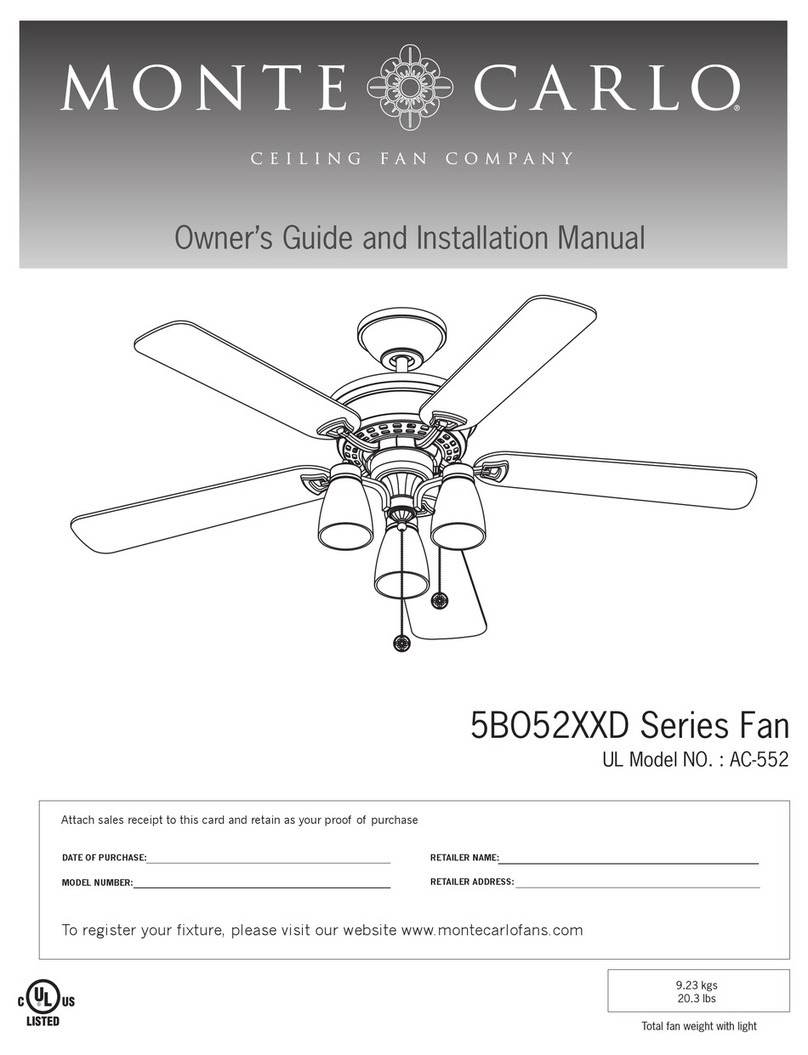
Monte Carlo Fan Company
Monte Carlo Fan Company Bravo 5BO52 D Series Owner's guide and installation manual
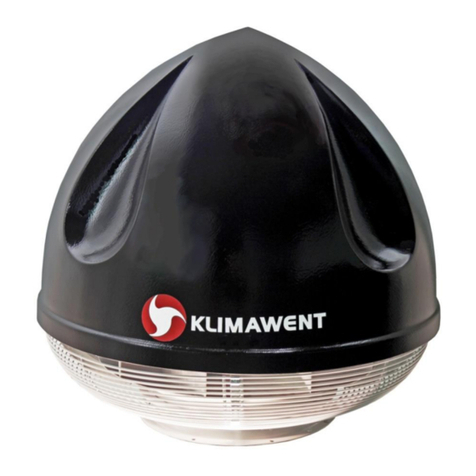
Klimawent
Klimawent SMART-N Series Use and maintenance manual
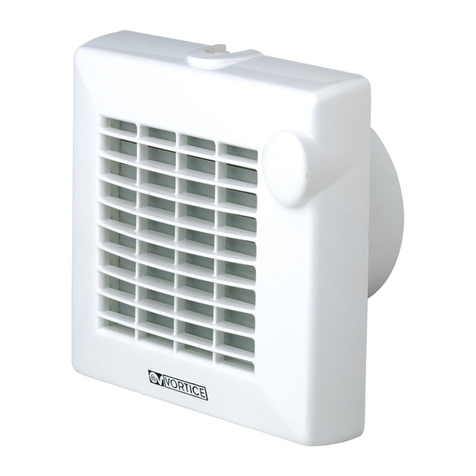
Vortice
Vortice PUNTO VORTICE M 90 Instruction booklet

Bimar
Bimar VTM30 quick start guide
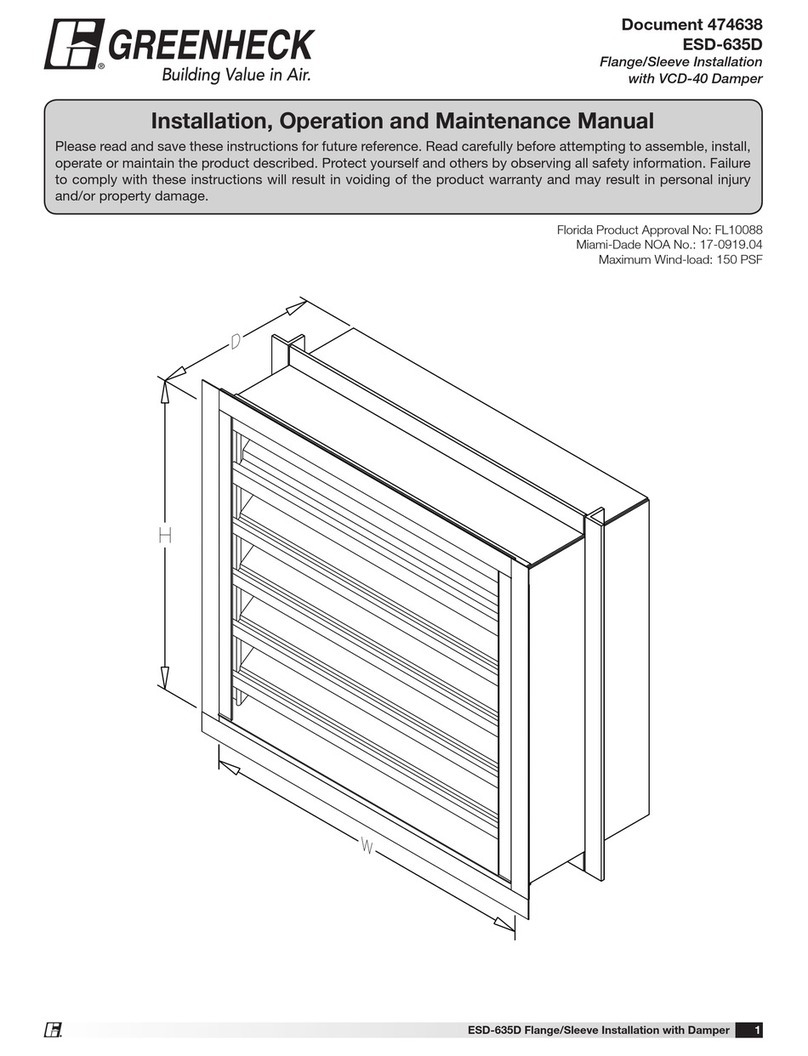
Greenheck
Greenheck ESD-635D Installation, operation and maintenance manual
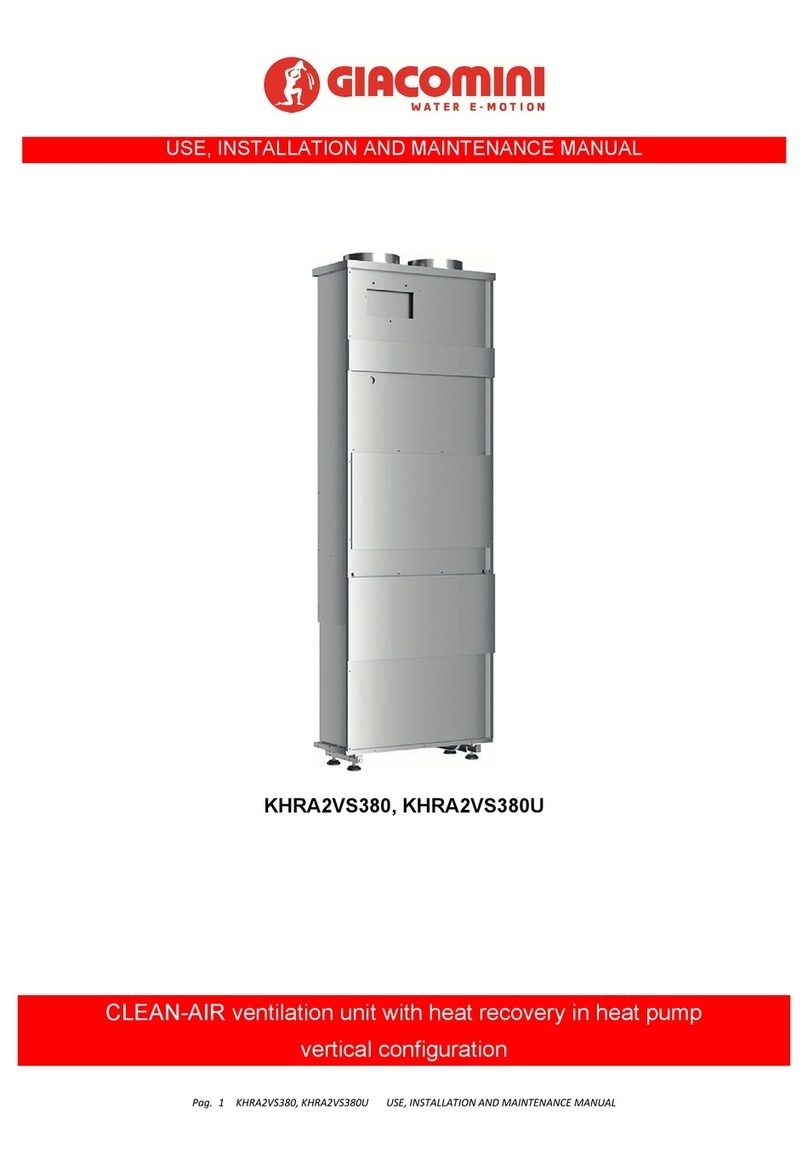
Giacomini
Giacomini CLEAN-AIR KHRA2VS380 Use, Installation and Maintenance Manual

